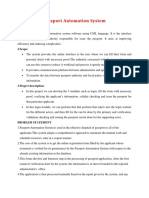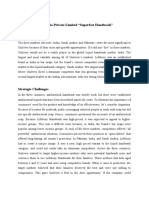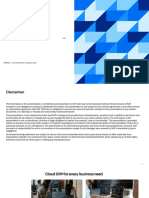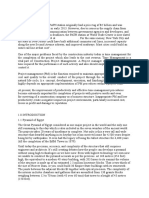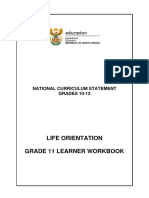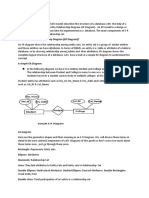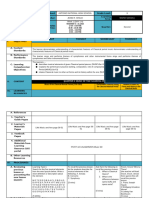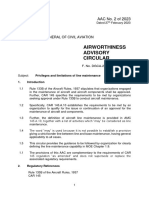SRS On Online Exam Registration System
SRS On Online Exam Registration System
Uploaded by
Kirupakaran HarikrishnanCopyright:
Available Formats
SRS On Online Exam Registration System
SRS On Online Exam Registration System
Uploaded by
Kirupakaran HarikrishnanOriginal Description:
Original Title
Copyright
Available Formats
Share this document
Did you find this document useful?
Is this content inappropriate?
Copyright:
Available Formats
SRS On Online Exam Registration System
SRS On Online Exam Registration System
Uploaded by
Kirupakaran HarikrishnanCopyright:
Available Formats
Software Requirements
Specification
for
EXAM REGISTRATION
SYSTEM
SVCE
20.03.2014
ii
Table of Contents
1. Introduction ................................................................................................................................1
1.1 Purpose .............................................................................................................................................. 1
1.2 Document Conventions ...................................................................................................................... 1
1.3 Product Scope .................................................................................................................................... 1
1.4 References .......................................................................................................................................... 2
2. Overall Description ....................................................................................................................2
2.1 Product Perspective ............................................................................................................................ 2
2.2 Product Functions .............................................................................................................................. 2
2.3 Operating Environment ...................................................................................................................... 3
2.4 Design and Implementation Constraints ............................................................................................ 3
2.5 Assumptions and Dependencies ......................................................................................................... 3
3. External Interface Requirements .............................................................................................3
3.1 User Interfaces ................................................................................................................................... 3
3.2 Hardware Interfaces ........................................................................................................................... 3
3.3 Software Interfaces ............................................................................................................................ 4
3.4 Communications Interfaces ................................................................................................................ 4
4. Functional Requirements ..........................................................................................................4
5. Other Non-functional Requirements........................................................................................5
5.1 Performance Requirements ................................................................................................................ 5
5.2 Safety and Security Requirements ..................................................................................................... 5
5.3 Business Rules ................................................................................................................................... 5
1
1. Introduction
Examinations used to test the understandability of the Student and his ability to recollect it,
using it in apt situation, reasoning and Analytics. Now a days, Instead of conducting examinations
in papers, mostly everything is done online. Starting from question paper setting and till the report
of statistical score is submitted online. Hence, we have developed an automatic exam registration
system.
1.1 Purpose
The developed product is a web-based examination registration system. It assists an
examiner to create an exam by adding and modifying questions, supplying possible results of a
question and selecting the intended group of students. Moreover the examination will have an
overview of the results of an exam by student, group or other factors. A student can solve exams for
which they are enrolled and view results and corrections of previous exams. The product benefits
the examiner by simplifying and speeding up the work of creating and correcting an exam and
provides an easy way to follow the results of a student or group of students. An administrator will
setup and maintain the enrolments and courses. The product will be entirely accessed by a user-
friendly web-interface which means that a minimum amount of computer knowledge is required to
interact with it. Authentication: Every user (examiner, Administrator etc.) is authenticated before
allowing to login.
Study-materials: study material is available on line and is accessible depending on modules cleared.
Result Analysis: Various results are prepared and also in-build functionality is available for analysis
of results.
Monitoring: Expert system can monitor students performance. The rules are added/modified by
experts when and as required.
1.2 Document Conventions
ERS: Exam Registration System
HTTP: Hyper Text Transfer Protocol
GUI: Graphical User Interface
WWW: World Wide Web
1.3 Product Scope
The developed project is supposed to have the following features
1. There are different kinds of Users (Administrator, Examiner, etc.) can log on to website and
access it.
2. There is a secure authentication system for different types of user access the website.
3. Each every user has own privilege to access the site.
4. Course materials are also available for different type of courses for which the student applies.
5. It is used to create or modify the exam, which is done by the examiner
2
6. It is also possible for the examiner to view the result of the student, department, College or
university.
7. Administrator is the one who takes care of the admissions, dates of examination and
maintaining the results of examination.
8. Administrator will register and authenticate the user before appearing for examination.
9. A secure examination system can be established through which the risk factors in
examination and mal practices during the examination can be avoided.
10. Results and statistics are published then and there in a fraction of time.
11. The results of previous examination and exams to be covered in future are also displayed.
12. All the above can be accessed in a user friendly interface for which very basic knowledge
about the computer is enough for understanding.
1.4 References
Craig Larman, Applying UML and Patterns, An Introduction to Object-Oriented Analysis and
Design and iterative Development
2. Overall Description
2.1 Product Perspective
The online exam registration system which includes registration, examinations and
publishing results. This will improve the effectiveness of the examination and also reduce the work
load of examiner by allocating the examination schedule based on the modules covered, allocating
time table of examination based on the chapter and subjects. Allowing access for various types of
users like Administrator, examiner, students, etc.
2.2 Product Functions
The examination registration system is a real time examination system which is used for
registering for the exam according to the available slots. More or less many product functions are
explained in the product perspective itself. Now let us see about the functional components.
1. Administrator is provided with the ultimate authority of read, edit, modify and delete all the
contents.
2. Examiner is privileged to add, change, edit, modify and update the date of the examination if
slots are available.
3. The student users are allowed to access the catalogue which consists of study materials for
many modules.
4. The student is also privileged to cancel or reschedule an examination on account of payment
5. A transaction slip is generated by the administrator after the registration
3
2.3 Operating Environment
The ERS Software is developed to work on all Java enabled web browsers. Itll work on all
Operating systems and requires an Internet connection.
2.4 Design and Implementation Constraints
1. The university information & communication system must be compatible with all the Web
browser, Internet Applications and platform independent.
2. The software should be connected to web server which runs 24x7.
3. The user accessing the system from any computer must have an internet connection with all
browsing capabilities.
4. GUI is available only in English
2.5 Assumptions and Dependencies
1. The users have sufficient knowledge of computers.
2. The remote computer should have Internet connection and Internet server capabilities.
3. The users know the English language, as the user interface will be provided in English.
3. External Interface Requirements
3.1 User Interfaces
1. Login Log into the system as a Student or Examiner
2. Course Registration Register for a course
3. Write Exam Answer questions, traverse between questions, submit answers
4. Results Results of previously written exams
5. Study Materials Download notes and other study materials
6. Feed Questions Feed questions and answers into the database
7. Reports Reports of student results
8. Administer Courses Availability, fee, add and remove courses
9. Administer Students Add, remove, manage students
3.2 Hardware Interfaces
Since the application does not have any designated hardware, it does not have any direct
hardware interfaces. The physical servers are managed by the servers OS. The hardware
connection to the database server is managed by the underlying operating system on the application
server and the system.
4
3.3 Software Interfaces
The system shall interface with an Oracle or MSSQL or MySQL database.
3.4 Communications Interfaces
The communication between the different parts of the system is important since they depend
on each other. However, in what way the communication is achieved is not important for the system
and is therefore handled by the underlying operating systems for both the application and the web
portal. Required protocols - HTTPS, FTP etc.
4. Functional Requirements
Use Case 1: Authenticate
Primary Actor: Student/Faculty
Pre-Condition: Nil
Post-Condition: Fetch and load the details of the user
Main Scenario:
1. Start the application. User prompted for login and password.
2. User gives the login and password.
3. System does authentication.
4. Selection screen is displayed.
Alternate Scenario:
5(a). Authentication fails
5(a)1. Prompt user about wrong password
5(a)2. Allow user to re-enter the password.
Use Case 2: Registration
Primary Actor: Student/Faculty
Pre-Condition: Student/Faculty selected the desired course.
Post-Condition: Store details in database.
Main Scenario:
1. Student/Faculty fills in the other details
2. Registers for the selected course.
Alternate Scenario:
3(a).Registration fails.
3(a)1. System asks the user to re-enter the details.
4(a). Connection gets terminated.
4(a)1.System redirects the user to Login or Selection Page.
5
Use Case 3: Take Test
Primary Actor: Student, System
Pre-Condition: Student enrolled in that course
Post-Condition: Store details in database
Main Scenario:
1. Questions are selected randomly and given to the student
2. Student submit the answers
3. System evaluates the answers
4. System displays result of the student
Alternate Scenario:
None
Use Case 4: Feed Questions
Primary Actor: Faculty, System
Pre-Condition: Faculty selected the desired course.
Post-Condition: Store details in database.
Main Scenario:
1. Faculty Provides the questions and answers to the questions
2. System stores the details in database
Alternate Scenario:
None
5. Other Nonfunctional Requirements
5.1 Performance Requirements
Performance requirements define acceptable response times for system functionality.
1. The load time for user interface screens shall take no longer than two seconds.
2. The log in information shall be verified within two seconds.
3. Queries shall return results within five seconds.
5.2 Security and Safety Requirements
Security: The files in which the information regarding securities and portfolios should be secured
against malicious deformations.
Fault Tolerance: Data should not become corrupted in case of system crash or power failure.
5.3 Business Rules
Server Administrator: under extreme circumstances the administrator has the privileges to back up
the datas but cant modify the contents.
User: has the rights to claim the payment made if the ticket is under waiting list on the date of the
journey but 10% will be deducted. The user will be able to book for just 6 persons at a time.
6
Analysis Models:
USECASE DIAGRAM:
It defines scenarios what are the functions used in the project and mention the participant or
actors involved in project and it should be a verb. Use case is represented as an eclipse with a name
inside it. It may contain additional responsibilities.
ACTIVITY DIAGRAM:
An Activity diagram shows sequential and parallel activities in a process they are useful for
modeling business process
Authenticate
7
Take Test
8
View Result
UML CLASS DIAGRAM:
It includes class diagrams to illustrate classes, interfaces and their associations .They are
used for static object modeling.
9
UML INTERACTION DIAGRAM:
Sequence Diagram:
Sequence diagrams are used as a notation that can illustrate actor interactions and the operations
initiated by them.
10
11
COMMUNICATION DIAGRAM:
Communication diagram is another form of interaction diagram. It represents the structural
organization of a system and the messages sent/received. Structural organization consists of objects and
links.
The purpose of communication diagram is similar to sequence diagram. But the specific purpose of
collaboration diagram is to visualize the organization of objects and their interaction.
UML STATE MACHINE DIAGRAM:
Any real time system is expected to be reacted by some kind of internal/external events. These events are
responsible for state change of the system.
State machine diagram is used to represent the event driven state change of a system. It basically describes
the state change of a class, interface etc.
Login
12
Take Test
UML COMPONENT DIAGRAM:
Component diagrams are used to describe the physical artifacts of a system. This artifact includes files,
executables, libraries etc.
13
DEPLOYMENT DIAGRAM:
Deployment diagrams are used to visualize the topology of the physical components of a system where the
software components are deployed. So deployment diagrams are used to describe the static deployment view
of a system. Deployment diagrams consist of nodes and their relationships.
14
Java Implementation
System.Java:
import java.lang.*;
import java.util.Set;
import javax.swing.*;
/**
* @author ita1143
* @generated "UML to Java V5.0
(com.ibm.xtools.transform.uml2.java5.internal.UML2JavaTransform)"
*/
public class System {
/**
* @generated "UML to Java V5.0
(com.ibm.xtools.transform.uml2.java5.internal.UML2JavaTransform)"
*/
private static Student student;
/**
* @uml.annotations for <code>examiner</code>
* collection_type="Examiner"
* @generated "UML to Java V5.0
(com.ibm.xtools.transform.uml2.java5.internal.UML2JavaTransform)"
*/
private static Set<Examiner> examiner;
private static LoginForm loginForm;
public static boolean Authenticate(int type, String id, String password) {
if(type == 2) {
if(id.equals("Kirupakaran") && password.equals("qwerty")) {
student = new Student();
StudentMainForm.init(student);
loginForm.setVisible(false);
}
}
else if(type == 1) {
if(id.equals("Kirupakaran") && password.equals("12345")) {
Examiner e1 = new Examiner();
ExaminerMainForm.init(e1);
loginForm.setVisible(false);
}
}
return false;
15
}
public static void main(String[] args) {
SwingUtilities.invokeLater(new Runnable() {
public void run() {
loginForm = new LoginForm();
loginForm.setDefaultCloseOperation(JFrame.EXIT_ON_CLOSE);
loginForm.setVisible(true);
}
});
}
}
LoginForm.Java:
import javax.swing.SwingUtilities;
import java.awt.BorderLayout;
import javax.swing.ButtonGroup;
import javax.swing.JPanel;
import javax.swing.JFrame;
import java.awt.FlowLayout;
import javax.swing.JLabel;
import javax.swing.JTextField;
import java.awt.Insets;
import java.awt.Rectangle;
import javax.swing.JRadioButton;
import javax.swing.JButton;
import javax.swing.JPasswordField;
public class LoginForm extends JFrame {
private static final long serialVersionUID = 1L;
private JPanel jContentPane = null;
private JPanel panel = null;
private JLabel login = null;
private JTextField loginField = null;
16
private JLabel pwd = null;
private JRadioButton studentRadiobtn = null;
private JLabel jLabel = null;
private JRadioButton examinerRadiobtn = null;
private JLabel jLabel1 = null;
private ButtonGroup bg1;
private JButton submit = null;
private JPasswordField pwdField;
/**
* This method initializes panel
*
* @return javax.swing.JPanel
*/
private JPanel getPanel() {
if (panel == null) {
panel = new JPanel();
panel.setLayout(new GridBagLayout());
panel.setBounds(new Rectangle(292, 16, 0, 150));
}
return panel;
}
/**
* This method initializes loginField
*
* @return javax.swing.JTextField
*/
private JTextField getLoginField() {
if (loginField == null) {
loginField = new JTextField(50);
loginField.setBounds(new Rectangle(134, 58, 133, 22));
}
return loginField;
}
/**
* This method initializes submit
*
17
* @return javax.swing.JButton
*/
private JButton getSubmit() {
if (submit == null) {
submit = new JButton("Login");
submit.setBounds(new Rectangle(169, 195, 66, 28));
submit.addMouseListener(new java.awt.event.MouseAdapter() {
public void mouseClicked(java.awt.event.MouseEvent e) {
if(studentRadiobtn.isSelected())
System.Authenticate(2, loginField.getText(),
String.valueOf(pwdField.getPassword()));
else if(examinerRadiobtn.isSelected())
System.Authenticate(1, loginField.getText(),
String.valueOf(pwdField.getPassword()));
//System.out.println("mouseClicked()"); // TODO Auto-
generated Event stub mouseClicked()
}
});
}
return submit;
}
/**
* This is the default constructor
*/
public LoginForm() {
super();
initialize();
}
/**
* This method initializes this
*
* @return void
*/
private void initialize() {
this.setSize(448, 321);
this.setContentPane(getJContentPane());
this.setTitle("Login");
}
/**
* This method initializes jContentPane
*
* @return javax.swing.JPanel
*/
18
private JPanel getJContentPane() {
if (jContentPane == null) {
jLabel1 = new JLabel();
jLabel1.setBounds(new Rectangle(261, 157, 74, 26));
jLabel1.setText("Examiner");
jLabel = new JLabel();
jLabel.setBounds(new Rectangle(134, 157, 61, 27));
jLabel.setText("Student");
pwd = new JLabel();
pwd.setBounds(new Rectangle(55, 107, 70, 16));
pwd.setText("Password");
login = new JLabel();
login.setText("Login ID");
login.setBounds(new Rectangle(55, 61, 59, 16));
jContentPane = new JPanel();
studentRadiobtn = new JRadioButton();
studentRadiobtn.setBounds(new Rectangle(104, 157, 21, 21));
studentRadiobtn.setSelected(true);
examinerRadiobtn = new JRadioButton();
examinerRadiobtn.setBounds(new Rectangle(226, 154, 17, 24));
bg1 = new ButtonGroup();
bg1.add(studentRadiobtn);
bg1.add(examinerRadiobtn);
jContentPane.setLayout(null);
jContentPane.add(login, null);
jContentPane.add(getPanel(), null);
jContentPane.add(getLoginField(), null);
jContentPane.add(pwd, null);
jContentPane.add(studentRadiobtn, null);
jContentPane.add(jLabel, null);
jContentPane.add(examinerRadiobtn, null);
jContentPane.add(jLabel1, null);
jContentPane.add(getSubmit(), null);
pwdField = new JPasswordField();
pwdField.setBounds(134, 105, 133, 21);
jContentPane.add(pwdField);
}
return jContentPane;
}
}
19
StudentMainForm.java:
import java.awt.BorderLayout;
import java.awt.EventQueue;
import javax.swing.JFrame;
import javax.swing.JPanel;
import javax.swing.border.EmptyBorder;
import javax.swing.JLabel;
import javax.swing.JButton;
import java.awt.event.ActionListener;
import java.awt.event.ActionEvent;
public class StudentMainForm extends JFrame {
private JPanel contentPane;
/**
* Launch the application.
*/
public static void init(final Student student) {
EventQueue.invokeLater(new Runnable() {
public void run() {
try {
StudentMainForm frame = new StudentMainForm(student);
frame.setVisible(true);
} catch (Exception e) {
e.printStackTrace();
}
}
});
}
/**
* Create the frame.
*/
public StudentMainForm(Student s) {
setDefaultCloseOperation(JFrame.DISPOSE_ON_CLOSE);
setBounds(300, 300, 500, 309);
contentPane = new JPanel();
contentPane.setBorder(new EmptyBorder(5, 5, 5, 5));
setContentPane(contentPane);
contentPane.setLayout(null);
JLabel lblWelcome = new JLabel("Welcome " + s);
lblWelcome.setBounds(20, 11, 159, 14);
20
contentPane.add(lblWelcome);
JLabel lblSelectAnOption = new JLabel("Select an Option");
lblSelectAnOption.setBounds(30, 44, 115, 14);
contentPane.add(lblSelectAnOption);
JButton btnWriteExam = new JButton("Write Exam");
btnWriteExam.setBounds(56, 95, 123, 23);
contentPane.add(btnWriteExam);
JButton btnSeeMarks = new JButton("See Marks");
btnSeeMarks.setBounds(56, 152, 123, 23);
contentPane.add(btnSeeMarks);
btnWriteExam.addMouseListener(new java.awt.event.MouseAdapter() {
public void mouseClicked(java.awt.event.MouseEvent e) {
WriteExamForm f = new WriteExamForm();
f.setVisible(true);
}
});
JButton btnEnrollInAnother = new JButton("Enroll in another course");
btnEnrollInAnother.setBounds(254, 95, 171, 23);
contentPane.add(btnEnrollInAnother);
JButton btnNewButton = new JButton("Check Study Materials");
btnNewButton.setBounds(254, 152, 171, 23);
contentPane.add(btnNewButton);
}
}
WriteExamForm.java:
import java.awt.BorderLayout;
import javax.swing.JPanel;
import javax.swing.JFrame;
import javax.swing.JLabel;
import java.awt.Rectangle;
import javax.swing.JRadioButton;
import javax.swing.ButtonGroup;
import java.awt.Dimension;
import javax.swing.JButton;
public class WriteExamForm extends JFrame {
private static final long serialVersionUID = 1L;
21
private JPanel jContentPane = null; // @jve:decl-index=0:visual-constraint="197,61"
private JLabel jLabel = null;
private JLabel jLabel1 = null;
private JRadioButton ans11 = null;
private JRadioButton ans12 = null;
private JRadioButton ans13 = null;
private JRadioButton ans14 = null;
private JLabel jLabel2 = null;
private JLabel jLabel3 = null;
private JLabel jLabel4 = null;
private JLabel jLabel5 = null;
private JButton Submit = null;
/**
* This is the default constructor
*/
public WriteExamForm() {
super();
initialize();
}
/**
* This method initializes this
*
* @return void
*/
private void initialize() {
this.setSize(500, 500);
this.setContentPane(getJContentPane());
this.setTitle("JFrame");
}
/**
* This method initializes jContentPane
*
22
* @return javax.swing.JPanel
*/
private JPanel getJContentPane() {
if (jContentPane == null) {
jLabel5 = new JLabel();
jLabel5.setBounds(new Rectangle(242, 229, 105, 16));
jLabel5.setText("Bjarne Stroustrup");
jLabel4 = new JLabel();
jLabel4.setBounds(new Rectangle(102, 229, 87, 16));
jLabel4.setText("Bill Gates");
jLabel3 = new JLabel();
jLabel3.setBounds(new Rectangle(242, 170, 106, 16));
jLabel3.setText("Ken Thompson");
jLabel2 = new JLabel();
jLabel2.setBounds(new Rectangle(102, 170, 89, 16));
jLabel2.setText("Dennis Ritchie");
jLabel1 = new JLabel();
jLabel1.setBounds(new Rectangle(52, 70, 280, 55));
jLabel1.setText("Who developed C?");
jLabel = new JLabel();
jLabel.setBounds(new Rectangle(36, 31, 87, 16));
jLabel.setText("Questions");
ButtonGroup bg1 = new ButtonGroup();
bg1.add(ans11);
bg1.add(ans12);
bg1.add(ans13);
bg1.add(ans14);
jContentPane = new JPanel();
jContentPane.setLayout(null);
jContentPane.setSize(new Dimension(490, 464));
jContentPane.add(jLabel, null);
jContentPane.add(jLabel1, null);
jContentPane.add(getAns11(), null);
jContentPane.add(getAns12(), null);
jContentPane.add(getAns13(), null);
jContentPane.add(getAns14(), null);
jContentPane.add(jLabel2, null);
jContentPane.add(jLabel3, null);
jContentPane.add(jLabel4, null);
jContentPane.add(jLabel5, null);
jContentPane.add(getSubmit(), null);
}
return jContentPane;
}
23
/**
* This method initializes ans1
*
* @return javax.swing.JRadioButton
*/
private JRadioButton getAns11() {
if (ans11 == null) {
ans11 = new JRadioButton();
ans11.setBounds(new Rectangle(72, 170, 21, 21));
}
return ans11;
}
/**
* This method initializes ans12
*
* @return javax.swing.JRadioButton
*/
private JRadioButton getAns12() {
if (ans12 == null) {
ans12 = new JRadioButton();
ans12.setBounds(new Rectangle(214, 170, 21, 21));
}
return ans12;
}
/**
* This method initializes ans13
*
* @return javax.swing.JRadioButton
*/
private JRadioButton getAns13() {
if (ans13 == null) {
ans13 = new JRadioButton();
ans13.setBounds(new Rectangle(72, 229, 21, 21));
}
return ans13;
}
/**
* This method initializes ans14
*
* @return javax.swing.JRadioButton
*/
private JRadioButton getAns14() {
24
if (ans14 == null) {
ans14 = new JRadioButton();
ans14.setBounds(new Rectangle(214, 229, 21, 21));
}
return ans14;
}
/**
* This method initializes Submit
*
* @return javax.swing.JButton
*/
private JButton getSubmit() {
if (Submit == null) {
Submit = new JButton();
Submit.setBounds(new Rectangle(177, 299, 105, 44));
Submit.setText("Submit");
Submit.addMouseListener(new java.awt.event.MouseAdapter() {
public void mouseClicked(java.awt.event.MouseEvent e) {
int x;
if(ans11.isSelected())
x = 1;
else
x = 0;
System.EvaluateResult(x);
}
});
}
return Submit;
}
}
ExaminerMainForm.java:
import java.awt.BorderLayout;
import java.awt.EventQueue;
import javax.swing.JFrame;
import javax.swing.JPanel;
import javax.swing.border.EmptyBorder;
import javax.swing.JLabel;
import javax.swing.JButton;
public class ExaminerMainForm extends JFrame {
25
private JPanel contentPane;
/**
* Launch the application.
*/
public static void init(final Examiner e) {
EventQueue.invokeLater(new Runnable() {
public void run() {
try {
ExaminerMainForm frame = new ExaminerMainForm(e);
frame.setVisible(true);
} catch (Exception e) {
e.printStackTrace();
}
}
});
}
/**
* Create the frame.
*/
public ExaminerMainForm(Examiner examiner) {
setDefaultCloseOperation(JFrame.EXIT_ON_CLOSE);
setBounds(100, 100, 450, 300);
contentPane = new JPanel();
contentPane.setBorder(new EmptyBorder(5, 5, 5, 5));
setContentPane(contentPane);
contentPane.setLayout(null);
JLabel lbl = new JLabel("Welcome " + examiner);
lbl.setBounds(21, 11, 201, 14);
contentPane.add(lbl);
JButton feedbtn = new JButton("Feed Questions");
feedbtn.setBounds(66, 36, 177, 30);
contentPane.add(feedbtn);
JButton checkStatusbtn = new JButton("Check Result Status");
checkStatusbtn.setBounds(66, 107, 177, 30);
contentPane.add(checkStatusbtn);
}
}
26
Sample Output:
27
28
RESULT:
Thus UML models for Exam Registration System have been designed and
implementation has been performed successfully using IBM Rational Software Architect.
You might also like
- Fee Management System - SRSDocument13 pagesFee Management System - SRSKshitij Minocha75% (4)
- Credit Card Processing: Problem StatementDocument48 pagesCredit Card Processing: Problem StatementAravind Duda100% (3)
- Ebook ManagementDocument33 pagesEbook ManagementBoova Ragavan80% (5)
- Conference Management System Uml DiagramsDocument9 pagesConference Management System Uml DiagramsComputer Science100% (2)
- Online Course Reservation SystemDocument16 pagesOnline Course Reservation SystemNishant Balasubramanian50% (2)
- Exam Registration SystemDocument12 pagesExam Registration SystemDeepak John61% (18)
- Software Personnel Management SystemDocument26 pagesSoftware Personnel Management SystemSubikshaa NarayananNo ratings yet
- E-Book Management SystemDocument21 pagesE-Book Management Systemajay10771% (17)
- Online Course Reservation SystemDocument56 pagesOnline Course Reservation SystemAisha Saran80% (5)
- Point of Sale Terminal Management System Construct A Design Element For PointDocument5 pagesPoint of Sale Terminal Management System Construct A Design Element For Pointdarshana gulhaneNo ratings yet
- Uml For Campus Recruitment SystemDocument15 pagesUml For Campus Recruitment SystemRass Seyoum50% (2)
- Student Management System Project ReportDocument60 pagesStudent Management System Project ReportAnkit Yadav100% (3)
- Srs For Student Attandance Management SystemDocument7 pagesSrs For Student Attandance Management SystemRohini60% (5)
- Online Course ReservationDocument23 pagesOnline Course Reservationthebhas1954No ratings yet
- Yang-Mills Theory On The Light ConeDocument14 pagesYang-Mills Theory On The Light Cones4suchiNo ratings yet
- Sample SRS Online Examination SystemDocument14 pagesSample SRS Online Examination SystemSoor Naik74% (23)
- Online Exam Registration SystemDocument7 pagesOnline Exam Registration SystemShravan thouti100% (7)
- E-Book MaanagementDocument12 pagesE-Book MaanagementSangeethRaj PS100% (1)
- 1 Passport Automation System PDFDocument22 pages1 Passport Automation System PDFganesh0% (1)
- Passport Automation SystemDocument9 pagesPassport Automation SystemSai100% (3)
- Passport Automation SystemDocument14 pagesPassport Automation SystemBoova Ragavan33% (6)
- Passport Automation System Srs PDFDocument5 pagesPassport Automation System Srs PDFPadmanaban MNo ratings yet
- Passport Automation SystemDocument16 pagesPassport Automation Systempranav0% (1)
- Online Registration System: Problem StatementDocument8 pagesOnline Registration System: Problem StatementPrasad Banoth0% (1)
- Conference Management System (UML Sequence and Collaboration Diagram)Document12 pagesConference Management System (UML Sequence and Collaboration Diagram)Siva siva100% (2)
- Foreign Trading SystemsDocument16 pagesForeign Trading SystemsAravind SivaNo ratings yet
- 2.book Bank Management SystemDocument68 pages2.book Bank Management SystemSuriyan Raveendiran Rajeswari67% (6)
- Model: To The "Course Registration System" With Various UML (Unified Modeling Language) DiagramsDocument13 pagesModel: To The "Course Registration System" With Various UML (Unified Modeling Language) Diagramsfree fireNo ratings yet
- 3 Exam Registration SystemDocument15 pages3 Exam Registration Systemganesh100% (5)
- Online Course Reservation System - FDocument18 pagesOnline Course Reservation System - FRamya S0% (1)
- 7.software Personnel ManagementDocument11 pages7.software Personnel Managementthebhas1954100% (1)
- Student Management System Project ReportDocument60 pagesStudent Management System Project ReportEmmanuel Masindike100% (1)
- Software Personnel Management: 1.problem StatementDocument2 pagesSoftware Personnel Management: 1.problem StatementaNo ratings yet
- 6 E-Ticketing SystemDocument20 pages6 E-Ticketing SystemGANESHKARTHIKEYAN V100% (1)
- Stock Maintenance SystemDocument12 pagesStock Maintenance Systemsaranya75% (4)
- SE Lab Manual R18Document60 pagesSE Lab Manual R18Sai Krishna100% (1)
- A Software Engineering Mini Project On Online Trading SystemDocument29 pagesA Software Engineering Mini Project On Online Trading SystemSai Ram100% (1)
- Credit Card UML DiagramDocument34 pagesCredit Card UML Diagramlakshmi prabha100% (4)
- Student Management System Project ReportDocument62 pagesStudent Management System Project ReportManoj institute100% (1)
- Online Examination System SynopsisDocument16 pagesOnline Examination System SynopsisAshish keer100% (2)
- 2 Book Bank Management System PDFDocument22 pages2 Book Bank Management System PDFganesh100% (4)
- College Management System Srs PDFDocument28 pagesCollege Management System Srs PDFNiranjan Reddy Ch100% (2)
- Book Bank Management System: Ex No: DateDocument23 pagesBook Bank Management System: Ex No: Datethebhas1954100% (2)
- OOAD Project - Book Bank Management SystemDocument14 pagesOOAD Project - Book Bank Management SystemTorfe RaajNo ratings yet
- College Information SystemDocument97 pagesCollege Information Systemsugarbaibs8970% (27)
- Online Course Registration System Project Report PDFDocument37 pagesOnline Course Registration System Project Report PDFSushant MishraNo ratings yet
- Software Requirements Specification: For Online Examination System "Assess You"Document13 pagesSoftware Requirements Specification: For Online Examination System "Assess You"Meenakshi GidkarNo ratings yet
- Project Report On Online Examination SystemDocument22 pagesProject Report On Online Examination SystemAyush BathreyNo ratings yet
- Raw Online Exam SystemDocument26 pagesRaw Online Exam SystempranavpfNo ratings yet
- Software Requirements Specification: Version 1.0 ApprovedDocument15 pagesSoftware Requirements Specification: Version 1.0 ApprovedHemshankar KumarNo ratings yet
- Online Examination System - ProjectDocument13 pagesOnline Examination System - Projectshivashis198890% (10)
- 1.1 Purpose: Software Requirement Specification For Online Examination SystemDocument13 pages1.1 Purpose: Software Requirement Specification For Online Examination SystemjenyalenthomasNo ratings yet
- Course Management SystemDocument88 pagesCourse Management SystemAnuj SinghNo ratings yet
- 20bit0294 VL2021220500413 Pe003Document36 pages20bit0294 VL2021220500413 Pe003Sanjay NithinNo ratings yet
- Exam RegistrationDocument7 pagesExam Registrationcsbs249055No ratings yet
- Virtual Class Room Ful 2024Document61 pagesVirtual Class Room Ful 2024saromacroNo ratings yet
- SRS of Online Quiz SystemDocument7 pagesSRS of Online Quiz Systemprafull100% (10)
- Solved Osee Sppu Q - PaperDocument18 pagesSolved Osee Sppu Q - PaperArkan IYINo ratings yet
- Software Requirements Specification: Version 1.0 ApprovedDocument20 pagesSoftware Requirements Specification: Version 1.0 ApprovedZain Ul Abedin SaleemNo ratings yet
- Sample SRS Online Examination SystemDocument14 pagesSample SRS Online Examination Systemjasmine_patel_10No ratings yet
- Software Testing Interview Questions You'll Most Likely Be AskedFrom EverandSoftware Testing Interview Questions You'll Most Likely Be AskedNo ratings yet
- Bright Wash-Safety Data SheetDocument8 pagesBright Wash-Safety Data SheetTariq khanNo ratings yet
- So 593 eDocument3 pagesSo 593 eshshsjajbbsjwbNo ratings yet
- DemintroDocument31 pagesDemintroiketNo ratings yet
- Case 2Document3 pagesCase 2gudetaNo ratings yet
- Chemicals Zetag DATA LDP Zetag 7878 FS 25 - 1110Document2 pagesChemicals Zetag DATA LDP Zetag 7878 FS 25 - 1110PromagEnviro.comNo ratings yet
- SmartSheet Testing - Learning LessonDocument39 pagesSmartSheet Testing - Learning LessonDiptendu MukherjeeNo ratings yet
- A Study On Mutual FundDocument66 pagesA Study On Mutual FundFaisal ArifNo ratings yet
- WR Cdsii 2022 Eng 230922Document24 pagesWR Cdsii 2022 Eng 230922manjeet singh sajwanNo ratings yet
- ArgumentsDocument8 pagesArgumentsZohaib AhmedNo ratings yet
- Chemistry Investigatory Project (NIVETHA)Document22 pagesChemistry Investigatory Project (NIVETHA)lakmi260107No ratings yet
- Module 10Document6 pagesModule 10Hazel PotterNo ratings yet
- Resume Word OriginDocument5 pagesResume Word Originaflkvapnf100% (1)
- Series 7 TR1 High Bin DatasheetDocument2 pagesSeries 7 TR1 High Bin DatasheetAalaaNo ratings yet
- 2024hkdse e ElangDocument4 pages2024hkdse e ElangScribdNo ratings yet
- L1 Solution Deck For SAP S4 HANA RetailDocument17 pagesL1 Solution Deck For SAP S4 HANA RetailbupeshNo ratings yet
- Miran Mcertificates PDFDocument19 pagesMiran Mcertificates PDFMIRAN KADRINo ratings yet
- The Great PyramidDocument10 pagesThe Great PyramidRajendiraperasad ManiamNo ratings yet
- 15 MW Kanfeng Hydropower ChinaDocument42 pages15 MW Kanfeng Hydropower Chinahumane28No ratings yet
- Bie South Africa Grade 11Document77 pagesBie South Africa Grade 11froggie :DNo ratings yet
- Catalogo ASCODocument4 pagesCatalogo ASCOIkaro MatosNo ratings yet
- MCQS Int332 - Devops Virtualization and Configuration ManagementDocument46 pagesMCQS Int332 - Devops Virtualization and Configuration ManagementAbhishek KumarNo ratings yet
- Oracle Solaris Guide For Linux Users: December 2016 (Edition 1.0) Fujitsu LimitedDocument74 pagesOracle Solaris Guide For Linux Users: December 2016 (Edition 1.0) Fujitsu LimitedShero KhanNo ratings yet
- SRS WANDERLUSTDocument21 pagesSRS WANDERLUSTk224827 Anum AkhtarNo ratings yet
- Implementing ADM1 For Plant-Wide Benchmark Simulations in Matlab/SimulinkDocument9 pagesImplementing ADM1 For Plant-Wide Benchmark Simulations in Matlab/SimulinkOmar AlmonteNo ratings yet
- Infosys PPT 13Document9 pagesInfosys PPT 13Durga Prasad SmartNo ratings yet
- Q2-Music 9-Week 1Document7 pagesQ2-Music 9-Week 1Mylene MirrarNo ratings yet
- A Study On Employee Retention in Rane Madras LTD, Chennai: Submitted byDocument76 pagesA Study On Employee Retention in Rane Madras LTD, Chennai: Submitted byJasmin RaichelNo ratings yet
- Aac02 2023Document6 pagesAac02 2023Sawan KumarNo ratings yet
- Define Quota Arrangement Usage: SAP - Customizing GuideDocument5 pagesDefine Quota Arrangement Usage: SAP - Customizing GuideJosé FaiaNo ratings yet






















